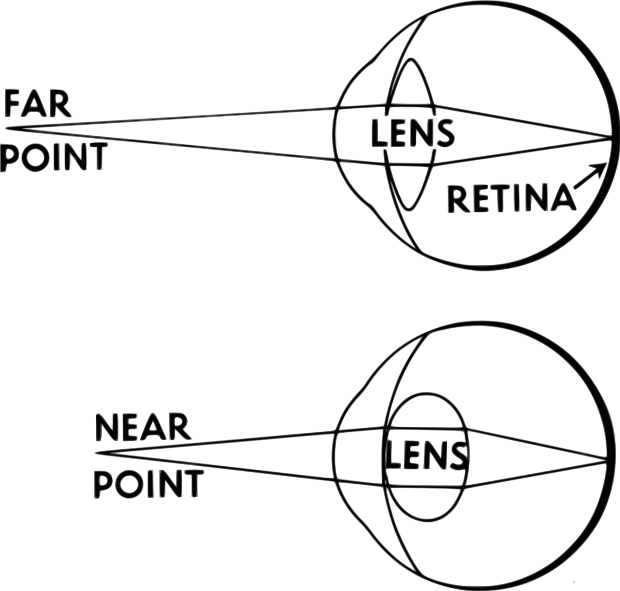為知 Accommodation 之語源,查了牛津字典
Origin
Early 17th century: from Latin accommodatio(n-), from accommodare ‘fit one thing to another’ (see accommodate).
找了字詞網絡詞彙資料庫
Omnilexica
For all your dictionary needs!
(physiology) the automatic adjustment in focal length of the natural lens of the eye
- domain: physiology
- lexical domain: Acts – nouns denoting acts or actions
- more generic words: adjustment / alteration / modification = the act of making something different
若問這很重要嗎?舉凡術語概念通常有其歷史,知道這個由來容易查找資料,貫串親疏遠近內蘊乎!恰似羅列多家文字
Accommodation (eye)
Accommodation (Acc) is the process by which the vertebrate eye changes optical power to maintain a clear image or focus on an object as its distance varies. Distances vary for individuals from the far point—the maximum distance from the eye for which a clear image of an object can be seen, to the near point—the minimum distance from the eye for which a clear image of an object can be seen.
Accommodation acts like a reflex, but can also be consciously controlled. Mammals, birds and reptiles vary the optical power by changing the form of the elastic lens using the ciliary body (in humans up to 15 dioptres). Fish and amphibians vary the power by changing the distance between a rigid lens and the retina with muscles.[1]

Minimum (top) and maximum accommodation (bottom)

Duane’s classical curves showing the amplitude or width of accommodation as changing with age. Mean (B) and approximate lower (A) and upper (C) standard deviations are shown[2])
The young human eye can change focus from distance (infinity) to as near as 6.5 cm from the eye.[3] This dramatic change in focal power of the eye of approximately 15 dioptres (the reciprocal of focal length in metres) occurs as a consequence of a reduction in zonular tension induced by ciliary muscle contraction. This process can occur in as little as 350 milliseconds[citation needed]. The amplitude of accommodation declines with age. By the fifth decade of life the accommodative amplitude can decline so that the near point of the eye is more remote than the reading distance. When this occurs the patient is presbyopic. Once presbyopia occurs, those who are emmetropic (do not require optical correction for distance vision) will need an optical aid for near vision; those who are myopic (nearsighted and require an optical correction for distance vision), will find that they see better at near without their distance correction; and those who are hyperopic (farsighted) will find that they may need a correction for both distance and near vision. Note that these effects are most noticeable when the pupil is large; i.e. in dim light. The age-related decline in accommodation occurs almost universally to less than 2 dioptres by the time a person reaches 45 to 50 years, by which time most of the population will have noticed a decrease in their ability to focus on close objects and hence require glasses for reading or bifocal lenses. Accommodation decreases to about 1 dioptre at the age of 70 years. The dependency of accommodation amplitude on age is graphically summarized by Duane’s classical curves.[2]
Theories of mechanism
- Helmholtz—The most widely held[4] theory of accommodation is that proposed by Hermann von Helmholtz in 1855. When viewing a far object, the circularly arranged ciliary muscle relaxes allowing the lens zonules and suspensory ligaments to pull on the lens, flattening it. The source of the tension is the pressure that the vitreous and aqueous humours exert outwards onto the sclera. When viewing a near object, the ciliary muscles contract (resisting the outward pressure on the sclera) causing the lens zonules to slacken which allows the lens to spring back into a thicker, more convex, form.
- Schachar—Ronald Schachar has proposed an alternative theory which indicates that focus by the human lens is associated with increased tension on the lens via the equatorial zonules; that when the ciliary muscle contracts, equatorial zonular tension is increased, causing the central surfaces of the crystalline lens to steepen, the central thickness of the lens to increase (anterior-posterior diameter), and the peripheral surfaces of the lens to flatten. While the tension on equatorial zonules is increased during accommodation, the anterior and posterior zonules are simultaneously relaxing.[5] The theory has not found support in scholarly Ophthalmology or Vision Science.
- Catenary—D. Jackson Coleman proposes that the lens, zonule and anterior vitreous comprise a diaphragm between the anterior and vitreous chambers of the eye.[6] Ciliary muscle contraction initiates a pressure gradient between the vitreous and aqueous compartments that support the anterior lens shape in the mechanically reproducible state of a steep radius of curvature in the center of the lens with slight flattening of the peripheral anterior lens, i.e. the shape, in cross section, of a catenary. The anterior capsule and the zonule form a trampoline shape or hammock shaped surface that is totally reproducible depending on the circular dimensions, i.e. the diameter of the ciliary body (Müeller’s muscle). The ciliary body thus directs the shape like the pylons of a suspension bridge, but does not need to support an equatorial traction force to flatten the lens.[7][8]
Induced effects of accommodation
When humans accommodate to a near object, they also converge their eyes and, as a result, constrict their pupils. However, the constriction of the pupils is not part of the process called lens accommodation. The combination of these three movements (accommodation, convergence and miosis) is under the control of the Edinger-Westphal nucleus and is referred to as the near triad, or accommodation reflex.[9] While it is well understood that proper convergence is necessary to prevent diplopia, the functional role of the pupillary constriction remains less clear. Arguably, it may increase the depth of field by reducing the aperture of the eye, and thus reduce the amount of accommodation needed to bring the image in focus on the retina.[10]
There is a measurable ratio between how much convergence takes place because of accommodation (AC/A ratio, CA/C ratio). Abnormalities with this can lead to many binocular vision problems.[citation needed]
The Wonder of Accommodation
……
![]()
The eye: optics, anatomy and accommodation.
The eye is an optical instrument and vision, in part, is a physical process. Here we relate the optics of the eye to its anatomy, describe the process of accommodation and the function of reading glasses. We compare the human eye with invertebrate eyes and with a camera. This page supports the multimedia tutorial The eye and colour vision.
- The eye and the camera: similarities and difference
- Anatomy and focussing
- Camera focussing
- Fish eye focussing
- Accommodation in the human eye
- Loss of accommodation and the use of reading glasses
- The retina
- Different retinal anatomies
- The blind spot
- What happens to the image on the retina?
───
惟求一統觀耳。倘說絕學,但讀李宗吾之《讀書三訣》哩☆
聽說一粒『小蘋果』讓『牛頓』開了竅,於是世界有了『力學』,至於傳說中的『厚黑教主』應啥入世,那位『張默生』這麼講︰
大概在南宋年間,廣東嘉應州長樂縣崛起一個姓李的人家,家長李子敏和他的兒子李上達,創家立業,慢慢家道興旺,子孫繁衍,就成了一個有名的氏族。後來代代相傳,傳到第十世上,有位名叫李潤唐的,于清代雍正三年,攜眷到四川來,先住隆昌蕭家橋,後遷富順自流井,遂在那里落籍了。四川自明末張獻忠大屠殺以後,地廣人稀,湖廣一帶的人民,都紛紛遷來居住,這個李姓人家的遷居 ,當亦不外此種原因。自李潤唐入川以來,家道又慢慢興旺,子孫繁衍,
傳到第八代上,出了一顆思想界的慧星,讀書窮理,好立異說,那便是以“面厚心黑”創立的李宗吾氏,這人自民國以來,已成四川的名人了。
我因避寇入川,得讀李氏的許多著作,由彼此通信,而得相晤識,而結為好友,始盡知他的生平行事和言論思想,他並不是象外間所傳的虛妄怪誕,立意在驚世駭俗的人,他的為人,既不面厚,也不心黑;但他偏偏提倡“厚黑學”,偏偏自稱為“厚黑教主”,這種“反話正說”的作風,究竟是為何而來?世人不必笑他罵他,應當先加以深切的反省才是,釋迦並不應該入地獄,耶穌並不應該釘十字架,但釋迦說︰“我不入地獄,誰入地獄?”耶穌偏 說︰“凡不背十字架走的人,不配做我們的門徒。”這又是所為何來?我們同樣應該加以反省的。至手李氏的談教育,談政治,談學術思想等,都是一本正經的立 論;不過他的思想有些奇僻,往往發前人之未發,言近人之未言 ,于是一般傳統的學者,就罵他是旁門外道罷了。如今李氏已作古人,再不怕他放言高論了,可是他一生的行事,尚為世人所不盡知 ,生前的言論思想,也有許多是被忽視的。我為紀念這位亡友起見 ,不惜筆墨,作此厚黑教主傳,好教世人藉以評定他的功罪。
李宗吾氏,生于光緒五年正月十三日。“宗吾”二宇,不是他的原名 ,這是他後來一再改定的。他的名號幾經改變,當他幼年的時候,脾氣非常蠻橫,毫不依理,見者呼為“人王”,他的父親就把“人王”二字,合為“全”字,加上輩“世”字,名為世全。算命先生說他命中少“金”就加上金旁,成為世銓﹐後來私塾先生又說他命中少“木”﹐並不少金,他也正嫌父親為他命的名不好,便自己改名世階字宗儒﹐這是表示信從孔子的意思。二十五歲,思想大變,對于儒教頗不滿意,心想與其宗法孔子,不如宗法自己,因改名為宗吾。他常說︰“這宗吾二字,是我思想獨立的旗幟。”以後宗吾,字行,而世階的名字,就幾乎無人知道了。
……
這似乎對一位『立教開宗』人物,缺少了那麼點神奇『徵兆』。想想從『南宋』到『光緒』,歷經十世八代,少說也有六七百年,據『亞聖』孟子《盡心下》說︰
由 堯、舜至於湯,五百有餘歲;若禹、皋陶則見而知之,若湯則聞而知之。由湯至於文王,五百有餘歲;若伊尹、萊朱則見而知之,若文王則聞而知之。由文王至於孔 子,五百有餘歲;若太公望、散宜生則見而知之,若孔子則聞而知之。由孔子而來,至於今,百有餘歲,去聖人之世,若此其未遠也;近聖人之居,若此其甚也。然 而無有乎爾!則亦無有乎爾!
,果然『應運而生』那
脾氣非常蠻橫,毫不依理,見者呼為“人王”
的李『教主』。話說那時正是『惡世』,『張之洞』提出
中學為體,西學為用。
,五濁 ── 貪、嗔、癡、慢、疑 ── 『俱全』,其父不解五行,以為合『人』『王』能求其『全』,又怎知應着『世』之輩分,卻種下了日後離棄『孔廟』之因。偏偏『教主』『十有五志於學』之時,恰逢『孫中山上李鴻章書』之事,加之以『西金』── 用銓 ── 剋『東木』── 改□ ── ,忿而願為『世人』之『階』,獨自『宗』『儒』學。可恨世間『不學有術』之『儒』太多,『媚外殘內』天下刀兵不斷,尚還稱『老佛爺吉祥』!於是乎不如『指天指地』唯我獨尊,做了個『自了漢』,立了個『厚黑教』,奮身一躍完成用『力學』來冶『心理』的宏願,但算算『人性』幾多情!惜哉 ,不通『術數』!只管『宗儒棄廟』,如果曾考之《姓名學》── 宋代蔡九峰皇極八十一數圖 ── ,當知『李宗吾』
『總格』二十二劃,象
秋草逢霜,懷才不遇,憂愁怨苦,事不如意。
凶
!!
多年前作者得此『奇書』,曾經嘗試用『宗吾』先生之
《讀書三訣》:
第一步,以古為敵。讀古人之書,就想此人是我的勁敵,有了他,就莫得我,非與他血戰一番不可。逐處尋他縫隙,一有縫隙,即便攻入;又代古人設法抗拒,愈戰愈烈,愈攻愈深。必要如此,讀書方能入理。
第二步,以古為友。我若讀書有見,即提出一種主張,與古人的主張對抗,把古人當如良友,互相切磋。如我的主張錯了,不妨改從古人;如古人主張錯了,就依著我的主張,向前研究。
第三步,以古為徒。著 書的古人,學識膚淺的很多,如果我自信學力在那些古人之上,不妨把他們的書拿來評閱,當如評閱學生文字一般。說得對的,與他加幾個密圈;說得不對的,與他 劃幾根杠子。我想世間俚語村言,含有妙趣的,尚且不少,何況古人的書,自然有許多至理存乎其中,我評閱越多,智識自然越高,這就是普通所說的教學相長了。 如遇一個古人,智識與我相等,我就把他請出來,以老友相待,如朱晦庵待蔡元定一般。如遇有智識在我上的,我又把他認為勁敵,尋他縫隙,看攻得進攻不進。
我雖然定下三步功夫,其實並莫有做到,自己很覺抱愧。我現在正做第一步功夫,想達第二步還未達到。至于第三步,自量終身無達到之一日。譬如行路,雖然把路徑尋出,無奈路太長了,腳力有限 ,只好努力前進,走一截,算一截。
○ 讀
《厚 黑學》、《厚黑叢話》、《我對聖人之懷疑》、《心理與力學 》、《制憲與抗日》、《社會問題之我見》、《政治經濟之我見》 、《中國民族特性之研究》、 《考試制度之商榷》、《中國學術之趨勢》、《迂老自述》、《我的思想統系》、《老婆經》,《厚黑學後傳》,《厚黑大全》,《厚黑原理》 ,《社會問題之商榷》。
無奈此法緩不濟急,敵不過『填鴨式』教育與『分數至上』主義。
─── 摘自《字詞網絡︰ WordNet 《四》 面厚心黑?!》